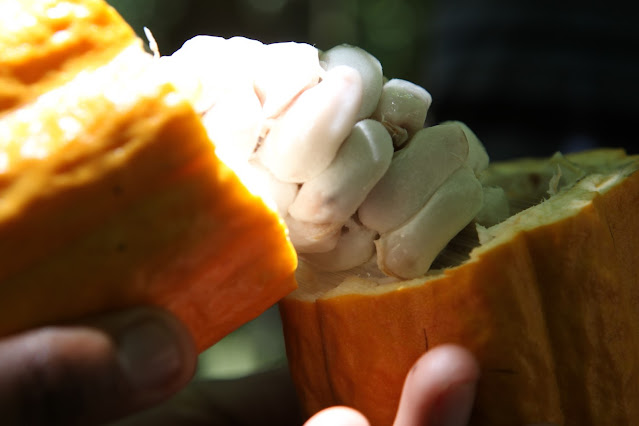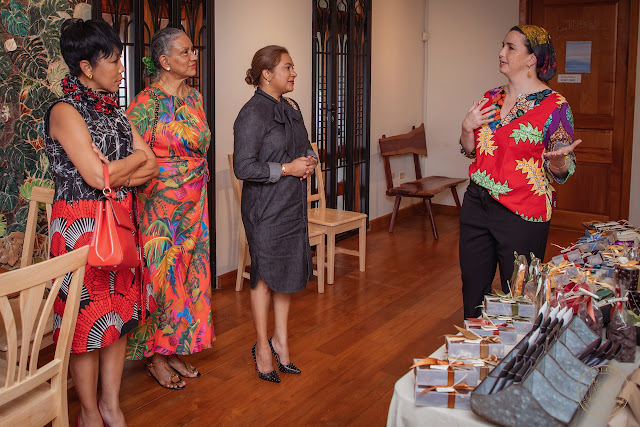The Cocoa Crisis in Trinidad and Tobago
Times of crisis are times of great opportunity, so the Chinese believe. What opportunities will the crisis of a shortage of cacao beans from Trinidad estates bring to a cadre of 21st century
chocolate makers? Pat Ganase surveys the Trinidad and Tobago industry.
“It is heart-breaking,” says Isabel Brash, “that cocoa production has been declining drastically over the last couple years. It is difficult to plan chocolate production and take orders for even a month in advance. The biggest season is fast approaching; for Christmas we start chocolate production in September.”
Over the past decade, the architect turned chocolate entrepreneur has built her business at the Cocobel chocolate house on Fitt Street using beans bought mainly from the Rancho Quemado estate. She has also worked with beans from other estates – La Deseada in Santa Cruz, San Antonio and independent farmer Anand Narine – and enjoys telling the stories of the flavours from each region. Her chocolate went to Italy for the Slow Food festival in three consecutive years.
 |
Cracked cocoa pod with juicy pulp around cocoa beans. |
Caribbean Chocolate
Trinidad and Tobago is one of six Caricom states (Saint Lucia, Belize, Dominica, Grenada, Jamaica are the others) among the mainly Caribbean and South American countries that are recognized by the International Cocoa Organisation (ICCO) as producers of “fine flavour” cocoa. For nearly 100 years, Trinidad and Tobago led the world in the research and development of the most widespread variety of cocoa now grown worldwide. Trinidad’s signature variety, Trinitario, was selected at the Imperial College of Agriculture (now The UWI St Augustine) and has continued to generate the stock for higher yielding, disease-resistant, flavourful cocoa.
The Cocoa Research Centre (CRC), successor to the Cocoa Research Unit of the Imperial College, maintains the International Cocoa Genebank, Trinidad (ICGT) one of the world’s precious collections of cocoa plant material. The establishment of the collection began in 1982. Since 1994, over 2000 types have been planted at a site in Centeno.
Cocoa History
At the height of its cocoa culture in the mid to late 1800s, Trinidad is reported (1865) to have had 14,238 acres under cocoa and coffee; over three million cocoa trees cultivated by some 700 owner / estates. Trinidad produced 20% of the world’s cocoa, some 30,000 tonnes of beans at the turn of the 20th century, mainly for export through the co-op system. Today, we barely produce 500 tonnes.
Estates – some overgrown, some being rehabilitated - may be found all over Trinidad. In Tobago, sugar gave way to cocoa; Charlotteville and Hermitage were large estates in the northeast. Trinidad’s cocoa crops failed in the 1920s due to disease. In Tobago, the pest was parrots and in 1963, Hurricane Flora.

Cocoa beans
dry on the floor of the cocoa house with a sliding roof.
New Players Old Agriculture
At the start of this century, chocolate making ignited the imagination of young entrepreneurs in an island that had previously produced cocoa beans for export. Cocobel was born in Brash’s mother’s kitchen.
Duane Dove’s Tobago Cocoa Estate was established in 2006, delivered its first harvest in 2009 and launched its single estate chocolate in 2010. Processed by French chocolatier Francois Pralus, Tobago Cocoa Estate is a premium award-winning chocolate exported around the world.
Other local chocolate brands available include: Brasso Seco Co-operative; Cocoa Republic; Exotic Caribbean Mountain Pride; Gina’s Fine Chocolates; Grande Riviere; House of Arendel; JB Chocolates; Kairi; Machel Montano; Montserrat Cocoa Farmers; Omarbeans; Ortinola; Panorama; Suneaters Organics; Tobago Estate Company; Tonči Chocolates (Tobago based); Ubergreen Organics among others. The CRC conducts regular chocolate making courses and manufactures a premium bar from harvests in the GeneBank.
The Trinidad and Tobago Fine Cocoa Company, now branded Trinitario, was established as a public-private sector partnership in 2013 with the aim of leading the rehabilitation of cocoa as an agri-tourism business through state of the art equipment and facilities, value added processing, new distribution channels, marketing, and highest quality assurance standards.
The CRC has started construction of a chocolate factory – funded through the public sector investment programme - on a 10-acre parcel of land within The UWI St Augustine Field Station. The factory will be equipped for making a range of chocolate products such as couverture, cocoa liquor, cocoa nibs, and is expected to be commissioned in January 2024.

Tiny pods and
flowers grow on the trunk of the cocoa tree.
Chocolate communities
Across the enterprise landscape, individuals and groups have gravitated to cocoa and chocolate.
Chocolate Rebellion is a project of the Alliance for Rural Communities (ARC), a non-profit organisation to support communities that process cocoa from trees in their area. ARC was founded in 2014 for residents of rural and semi-rural communities “to ensure wealth distribution and environmentally sustainable income generation in financially excluded rural Caribbean communities, with strategic focus on the cacao sector …through chocolate making.”
The Original Trinitario Cocoa and Chocolate (OTC) not for profit organization is intended to be a catalyst for sustainable growth of the cocoa industry in the Caribbean, generating foreign exchange and offering diversified employment throughout the value chain. Membership in the OTC includes cocoa growers, suppliers, buyers and down-stream processors, with support and contributions from government and regional agricultural research centres.

Empty cocoa
pods to be returned to the soil after harvest.
Resilience and Sustainable Harvests
Recently, farmers are reporting that the cocoa yields from estates have dropped. One farmer says his yield in 2021 fell by over 30% of the previous year; and in 2022, the yield was 30% less than in 2021. Will the cocoa crop rebound in 2023, a drier year?
“Where has all the cocoa gone?” was the subject of an ARC hosted online conversation on July 5 for growers and producers to brainstorm solutions to the shortages that chocolate producers are experiencing.
The CRC, on World Chocolate Day, July 7, posted on its facebook page, “Climate change poses a risk to the chocolate bar’s critical ingredient – the cacao bean. Changes in temperature and rainfall directly affect cacao yields.”
The Ministry of Agriculture and the CRC have offered skills training and services to revitalize estates. It requires science and work to replenish soils that have been producing cocoa – even when no one was reaping – for a couple hundred years.
Sarah Bharath, who consults with growers in Trinidad, Jamaica and St Vincent to improve post harvest processing, says, “I realise that many of us do not understand how soil works, and how cocoa as a living organism requires suitable environments. This results in a piece-meal approach to cocoa production with generic recommendations that do not meet the needs of the diverse locations and conditions across Trinidad and Tobago.
“Yields have been diminishing for a long time now. At the plant-system level, there has to be a return to first principles, understanding how this crop within its environment needs to be managed to establish systems resilient to environmental changes which will then help with productivity, vigor, and recovery if we are to have an industry for decades to come. We have a lot of work to do. Mission possible.”
A few farmers have already adopted syntropic methods of cultivation, returning valuable waste from the cocoa harvests to the soil. But “there’s no quick fix,” says Bharath.
In the meantime, quotas contracted with international chocolate companies cannot be met. And local chocolate makers have run out of sources of beans; some are attempting to outbid buyers for beans intended for overseas markets.
The reputation of Trinidad’s chocolatiers has grown in just a few years. They are cultivating a taste for authentic Trinitario chocolate among TT citizens as well as preparing quality products for international markets. The challenge now is to improve estate capacity in step with growing local demand for Trinidad beans.
Cocoa is a product rooted in earth, that has shaped culture, entrepreneurship and co-operatives in Trinidad and Tobago. Its cultivation had fallen out of practice for generations. Now that chocolate business is growing through new enterprise, what are the innovations and opportunities that will see the return to another golden age of cocoa.
CARICOM VISITORS TO COCOBEL




